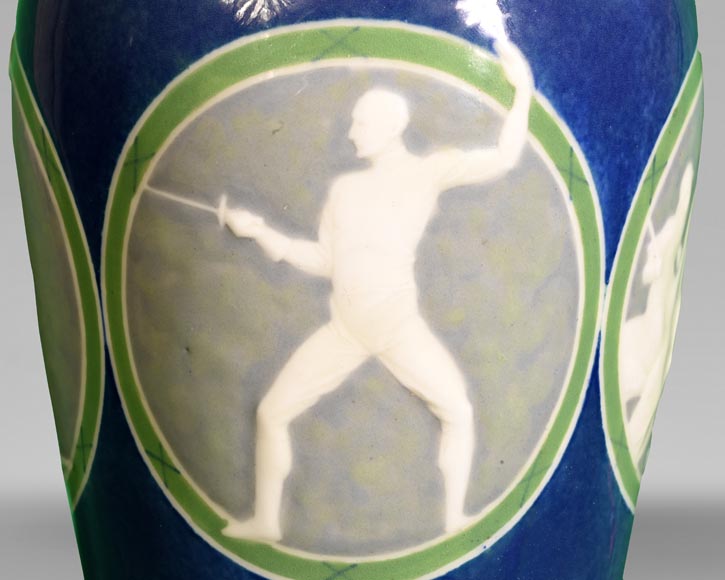Style Art Deco / Ref.13009
Émile BRACQUEMOND, Octave GUILLONNET, Winner's vase, 1924
Dimensions
Height 13'' 33cm
diameter: 5'' ⅞ 15cm
Origin:
France
This vase was created by the painter Octave Guillonnet and the ceramicist Émile Bracquemond for the Sèvres Manufacture on the occasion of the Paris Olympic Games in 1924.
Octave Guillonnet (Paris, 1872-Montgeron, 1967) was an Orientalist painter who could also be considered a sports painter: he notably exhibited a monumental “rugby match” at the 1899 salon. He was also a member of the Society of Sport Painters and Sculptors from its foundation in 1922.
The career of Émile Bracquemond (Paris, 1889-Clichy, 1970) is less well-known. However, it seems that besides his collaboration with the Sèvres Manufacture, he was particularly recognized for his feline sculptures.
The order for commemorative vases to be awarded to the winners of sporting events was placed by the city of Paris in anticipation of the 1924 Olympic Games to promote the production of the Sèvres Manufacture. Although Pierre de Coubertin was opposed to awarding trophies to winners, the project, once launched, was completed for this edition only. Subsequently, the rules were changed, and winners were awarded only medals.
The shape of this vase is very simple: the body flares out in an almost straight line from the base to two-thirds of its height before tapering towards the neck. The neck is adorned with a gray band bordered by a gold stripe, decorated with silhouettes of biplanes left in reserve. The body of the vase, with its subtly shaded blue glaze, features four pâte-sur-pâte scenes, each honoring a different sport. In the case of our vase, polo, Basque pelota (the athlete holds a chistera), and gymnastics apparatus are represented. The sports are depicted very precisely, with each discipline represented by a characteristic gesture. The slight relief of these decorations gives them greater depth and liveliness. While the winner’s vases were usually covered with a gold and brown decoration representing laurel branches, ours has a plain blue background that distinguishes it from the others.
Not all the disciplines represented on our vase were Olympic sports in 1924. Indeed, Basque pelota was only presented as a demonstration sport at this edition of the competition. Moreover, polo, which was an Olympic sport in 1924, is no longer part of the Games today.
There are four models in total for these commemorative vases, each depicting four different sports. The Sports Museum has a copy of each model, providing a complete overview. The sports represented on the other vases are as follows: rugby, rowing, diving, and football; javelin, wrestling, shot put, and boxing; tennis, cycling, sailing, and shooting.
This winner’s vase is therefore both a historical and artistic testament to the 1924 Olympic Games, which will resonate on the centenary of this event and the Paris Olympic Games in 2024, particularly within the framework of the edition by the manufacture of trophy vases created by six artists from the Beaux-Arts de Paris, intended to be awarded to the French gold medalists at the Paris 2024 Games.
Informations
Price: on request
Recommended for you :
Dimensions:
Height: 55
Diameter: 24
Dimensions:
Width: 45
Height: 25
Diameter: 45
Dimensions:
Height: 33
Diameter: 36
Dimensions:
Width: 33
Height: 4
Depth: 33
Dimensions:
Height: 37
Diameter: 40
Dimensions:
Width: 55
Height: 23
Depth: 23
Dimensions:
Width: 44
Depth: 25
Dimensions:
Width: 24
Height: 12
Depth: 8
Dimensions:
Height: 33
Diameter: 55
Dimensions:
Width: 26
Height: 17
Depth: 15
Dimensions:
Height: 3
Diameter: 32
Dimensions:
Height: 21
Diameter: 20
























